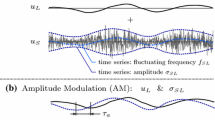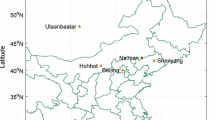Abstract
Statistical tools based on the maximal overlap discrete wavelet transform (MODWT) are reviewed, and then applied to a dataset of aircraft observations of the atmospheric boundary layer from the tropical eastern Pacific, which includes quasi-stationary and non-stationary segments. The wavelet methods provide decompositions of variances and covariances, e.g. fluxes, between time scales that effectively describe a broadband process like atmospheric turbulence. Easily understood statistical confidence bounds are discussed and applied to these scale decompositions, and results are compared to Fourier methods for quasi-stationary turbulence. The least asymmetric LA(8) wavelet filter yields coefficients that exhibit better uncorrelatedness across scales than the Haar filter and is better suited for decomposition of broadband turbulent signals. An application to a non-stationary segment of our dataset, namely vertical profiles of the turbulent dissipation rate, highlights the flexibility of wavelet methods.
Similar content being viewed by others
Abbreviations
- ANOVA:
-
Analysis of Variance
- DWT:
-
Discrete Wavelet Transform
- EDOF:
-
Equivalent Degrees Of Freedom
- LA:
-
Least Asymmetric
- MODWT:
-
Maximal Overlap Discrete Wavelet Transform
- PSD:
-
Power Spectral Density
- SST:
-
Sea Surface Temperature
References
Aldrich, E. (2005). ‘Alternative Estimators for Wavelet Variance’ Master’s thesis, Department of Statistics, University of Washington, Seattle, WA
Cornish C. R., Percival D. B., Bretherton C. S. (2003). ‘The WMTSA Wavelet Toolkit for Data Analysis in the Geosciences’. EOS Trans AGU. 84(46): Fall Meet. Suppl., Abstract NG11A-0173
Craigmile, P. F. and Percival, D. B. (2005). ‘Asymptotic Decorrelation of Between-Scale Wavelet Coefficients’. IEEE Transactions on Information Theory 51, 1039–1048
Daubechies, I. (1992). Ten Lectures on Wavelets, SIAM, Philadelphia
De Szoeke, S. P., Bretherton, C. S., Bond, N. A., Cronin, M. F., and Morley, B. (2005). ‘EPIC 95° W Observations of the Eastern Pacific Atmospheric Boundary Layer from the Cold Tongue to the ITCZ’. J. Atmos. Sci. 62, 426–442
Garratt, J. R. (1992). The Atmospheric Boundary Layer Cambridge University Press, Cambridge, 316 pp.
Grossman, R. L. (1982). ‘An Analysis of Vertical Veolcity Spectra Obtained in the BOMEX Fair-Weather, Trade-Wind Boundary Layer’ Boundary-Layer Meteorol. 23, 323–357
Howell, J. F. and Mahrt, L (1995). ‘Multiresolution Flux Decomposition’. Boundary-Layer Meteorol. 83, 117–137
Kaimal, J. C., Wyngaard, J. C., Haugen, D. A., Coté, O. R., Izumi, Y., Caughey, S. J., and Readings, C. J. (1976). ‘Turbulent Structure in the Convective Boundary Layer’. J. Atmos. Sci. 33, 2152–2169
Katul, G. G. and Parlange, M. B. (1994). ‘On the Active Role of Temperature in Surface-Layer Turbulence’. J. Atmos. Sci. 51, 2181–2195
Katul, G. G. and Parlange, M. B. (1995). ‘The Spatial Structure of Turbulence at Production Wavenumbers using Orthonormal Wavelets’. Boundary-Layer Meteorol. 75, 81–108
Kwon, B. H., Bé nech, B., Lambert, B., Durand, P., Druilhet, A., Giordani, H., and Planton, S. (1998). ‘Structure of the Marine Atmospheric Boundary Layer Over an Oceanic Thermal Front: SEMAPHORE Experiment’ J. Geophys. Res. 103(C11), 25159–25180
Mallat, S. G. (1989). ‘A Theory for Multiresolution Signal Decomposition: The Wavelet Representation’. IEEE Trans. Pattern Anal. and Machine Intell. 11, 674–93
Percival, D. B. and Walden, A. T. (1993). Spectral Analysis for Physical Applications: Multitaper and Conventional Univariate Techniques Cambridge University Press, Cambridge
Percival, D. B. and Walden, A. T. (2000). Wavelet Methods for Time Series Analysis. Cambridge University Press, Cambridge
Raymond, D. J., Esbensen, S. K., Paulson, C., Gregg, M., Bretherton, C. S., Petersen, W. A., Cifelli, R., Shay, L. K., Ohlmann, C., and Zuidema, P. (2004). ‘EPIC2001 and the Coupled Ocean-Atmosphere System of the Tropical East Pacific’. Bull. Amer. Meteor. Soc. 85, 1341–1354
Réchou, A., Durand, P., Druilhet, A., and Bénech, B. (1995). ‘Turbulence Structure of the Boundary Layer below Marine Clouds in the SOFIA Experiment’. Ann. Geophysicae 13, 1075–1086
Stull, R. B. (1988). An Introduction to Boundary Layer Meteorology. Kluwer Academic Publishers, Dordrecht, 666 pp.
Whitcher, B. J., Guthorp, P., and Percival, D. B. (2000). ‘Wavelet Analysis of Covariance with Application to Atmospheric Time Series’ J. Geophys. Res. 105(D11), 14941, 14962
Author information
Authors and Affiliations
Corresponding author
Rights and permissions
About this article
Cite this article
Cornish, C.R., Bretherton, C.S. & Percival, D.B. Maximal Overlap Wavelet Statistical Analysis With Application to Atmospheric Turbulence. Boundary-Layer Meteorol 119, 339–374 (2006). https://doi.org/10.1007/s10546-005-9011-y
Received:
Published:
Issue Date:
DOI: https://doi.org/10.1007/s10546-005-9011-y




